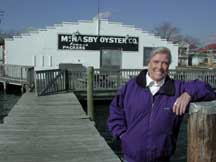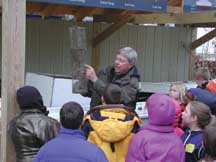Preserving
Our
Maritime Heritage
By Cindy Edwards

Nautical ambiance
is one of the many defining characteristics of Annapolis, and
abundance comes to mind when recalling our many gifts from the
Bay. There's sailing, crabbing, cruising, kayaking, fishing, windsurfing---and,
yes, there was Isabel.
The Chesapeake Bay is the largest estuary in the United States
and produces more seafood than any other comparable body of water.
The Bay and its many tributaries have nearly 12,000 miles of shoreline---more
than the entire West Coast---and give Maryland one of the longest
waterfronts in the country. It also supports an ecosystem whose
complexity and adaptation is nearly unfathomable.
 Dive
into the history of the Bay and you will be immersed in a similar
bounty. City dock was once a thriving international seaport where
ships traded cargo that ranged from tobacco to slaves. Our ancestors
are Native Americans, watermen and boat builders, and the evidence
of their lives surrounds us---yet so many of their stories remain
untold. Dive
into the history of the Bay and you will be immersed in a similar
bounty. City dock was once a thriving international seaport where
ships traded cargo that ranged from tobacco to slaves. Our ancestors
are Native Americans, watermen and boat builders, and the evidence
of their lives surrounds us---yet so many of their stories remain
untold.
For these reasons and so many more there is the Annapolis Maritime
Museum whose mission is "to teach and inspire residents and visitors,
young and old, through the rich maritime heritage of Annapolis
and the Chesapeake Bay."
"Our city is rooted in more than 400 years of maritime history.
The interstate highway of the 1800s was the Chesapeake Bay, and
Annapolis was a major port," says Buck Buchanan, chairman of the
board of directors for the Annapolis Maritime Museum. "We ought
to know more about the hard work---and fun---of our ancestors
who created this very successful village in which we live. These
people are our heroes and their stories our inspiration."
Recently, Mayor Ellen Moyer appointed Buchanan special assistant
to the mayor for maritime heritage. In this position, he will
represent the city in the development of programs dedicated to
the preservation and presentation of the region's 400-year-old
maritime heritage.
Buchanan's passion for the museum is splashed with the business
savvy he acquired as an executive for the H. J. Heinz Company.
"Our vision is a world-class maritime museum that not only houses
these stories and the artifacts that support them but also provides
an innovative learning adventure," says Buchanan. "There will
be a hands-on crab experience, oyster tonging, boat rides and
concerts. Combine this with a café, wetlands garden, kayak/canoe
launch area, picnic tables and docks and you have a glimpse of
the museum concept."
 The
museum had most recently made its home in the 100-year-old McNasby's
Oyster Company building and Barge House but was one of the many
structures devastated by Hurricane Isabel. The museum board had
also been prepared to launch a massive capital campaign. The
museum had most recently made its home in the 100-year-old McNasby's
Oyster Company building and Barge House but was one of the many
structures devastated by Hurricane Isabel. The museum board had
also been prepared to launch a massive capital campaign.
"Most of the exhibits were saved thanks to dozens of volunteers
who came down both before and after the storm," says Buchanan.
"However, we did lose our boat, Miss Lonesome, and a model of
the Thomas Point Lighthouse along with our computers, copier and
furniture. But our commitment and enthusiasm remains untouched."
The board has strategically re-charted their course and continues
their voyage toward a state of the art museum.
Interestingly, just as a storm has ecological benefits it also
stimulated growth within the paradigm of the museum. "Our outreach
program has accelerated as a result of our headquarters being
destroyed," says Buchanan. "Current projects and lectures are
being held at alternative locations, and we are so appreciative
for the concern our community has expressed."
The maritime museum has a network that includes the City of Annapolis,
Chesapeake Bay Foundation, Thomas Point Lighthouse Society, Historic
Annapolis Foundation, National Park Service and Watermark Cruises.
They also have musical support. "Them Eastport Oyster Boys" perform
regularly for the museum and the events it sponsors. "[They] have
been invaluable to our cause," says Buchanan. "They've contributed
an incalculable amount of time and effort, and we are so grateful
to them."
The Annapolis Maritime Museum has been a valuable work in progress
for more than 16 years. At the heart of the project is one of
its founding mothers and Annapolis legend, Peg Wallace. "Long
ago, a team of us gathered in our living rooms and on our porches
to discuss plans and strategies for a maritime museum," Wallace
says. "It only seemed logical since water is the key element of
our past. If there is any place that needs to talk about maritime
history, it is Annapolis.
"We have so many important stories to share," says Wallace. "And
when we obtained the Barge House location, we finally had a place
to show our exhibits." The historical displays of which she speaks
include depictions of places such as Horn Point and the boatyards
of Eastport. They also bestow the stories behind the faces of
our ancestors, like that of Eastport waterman Herbie Sadler and
the legacy of his shellfish traditions. The museum operated from
the 600-square-foot Barge House location for years before expanding
to the McNasby's building.
 "Eventually,
we realized that our mission was even larger than we imagined,"
Wallace explains. "When we outgrew the Barge House location, we
began to see the enormous potential of the maritime museum and,
thankfully, we recruited Buck Buchanan. I couldn't believe that
his passion for the museum was equal to mine, and he had a background
as business executive which gave him the knowledge to bring a
more sophisticated museum to life." Her respect for Buchanan and
his wife Marsha is as obvious as her pride and love for Annapolis. "Eventually,
we realized that our mission was even larger than we imagined,"
Wallace explains. "When we outgrew the Barge House location, we
began to see the enormous potential of the maritime museum and,
thankfully, we recruited Buck Buchanan. I couldn't believe that
his passion for the museum was equal to mine, and he had a background
as business executive which gave him the knowledge to bring a
more sophisticated museum to life." Her respect for Buchanan and
his wife Marsha is as obvious as her pride and love for Annapolis.
Buchanan displays a mutual respect. "When I signed on as chairman,
I agreed to try and take the place of Peg Wallace, but have found
it virtually impossible, because she is one of the most amazing
individuals I have ever met," says Buchanan. "She has poured heart
and soul into the museum, and I am committed to this project,
not only because it is an important gift to the community but
also because the work Peg Wallace has done ought to be perpetuated."
One of the many heroes the museum celebrates is Capt. Van Horn
Weems, the father of modern navigation. According to the exhibit,
"he moved to Annapolis from a small town in Tennessee and graduated
from the Naval Academy in 1912. Capt. Weems was a navigational
genius who modernized the art of celestial navigation by simplifying
techniques and inventing the time-saving methods that guided commercial
naval vessels through the 1900s. He went on to become an expert
in aviation navigation and served as an advisor to Charles Lindbergh,
Amelia Erhart and Pan American Airways when commercial flight
was just beginning. Ultimately, he was an advisor for NASA." The
Weems exhibit is on display at Weems & Plath, 214 Eastern Avenue
in Eastport, through January 31.
The museum also commemorates a not-so- well-known story about
the Peggy Stewart, an 1800s-era trading ship. In order to protest
the British tea tax, residents did not just dump the tea as they
did in Boston. They actually burned the ship right here in our
very own harbor. Stories like these are plentiful, and the museum
aims to provide a forum for these integral pieces of our maritime
history. Since its inception, the maritime museum has won several
awards for its work. Most recently, Historic Annapolis Foundation
presented it with a preservation award for its boatshed exhibit.
The benefits of a maritime museum are numerous. "The values and
excitement found in our maritime heritage can strengthen the social
fabric of our community and assist in raising environmental awareness
for the Chesapeake Bay," Buchanan says. "It can also greatly enrich
the experience of our visitors and encourage them to return."
There are four legs to the museum's program: The heritage leg
teaches stories about the people and events that have shaped our
local history. The school leg provides hands-on learning, job
training and community service activities for students. The environmental
leg encourages the preservation of the foundation of our heritage---the
Chesapeake Bay. And the economic leg increases tourism revenue
by providing an attraction, thus inspiring visitors to stay longer.
But funds remain the biggest challenge for the maritime museum.
"Our need for community support is nothing short of crucial,"
says Jeff Holland, museum director. "We can keep the vision alive
and become a positive force if the community has the will and
the commitment to make it happen." The museum welcomes any form
of donation, from office equipment to monetary contributions.
Yes, it's undeniable that our history is drenched with influence
from the Chesapeake Bay. Quite simply, it was the Bay that brought
our ancestors here in the first place, both literally and figuratively.
The Annapolis Maritime Museum honors our maritime heritage and
celebrates the richness of our culture.
This fusion of past and present lends a voice to the tides of
time that echo throughout our city and plants seeds for an abundant
harvest of the future. An old African proverb says "it takes a
village to raise a child." Advocates of the Annapolis Maritime
Museum believe "it takes a community to preserve and celebrate
a maritime heritage."
For more information or to make a donation, please call 410-295-0104
or visit the website at www.annapolismaritimemuseum.org.
 Cindy
Edwards enjoys the adventure of life and writing about it.
She is an avid reader, traveler and yoga practitioner who
resides in Annapolis with her husband and her dog. Cindy
Edwards enjoys the adventure of life and writing about it.
She is an avid reader, traveler and yoga practitioner who
resides in Annapolis with her husband and her dog.
|
Back
|

